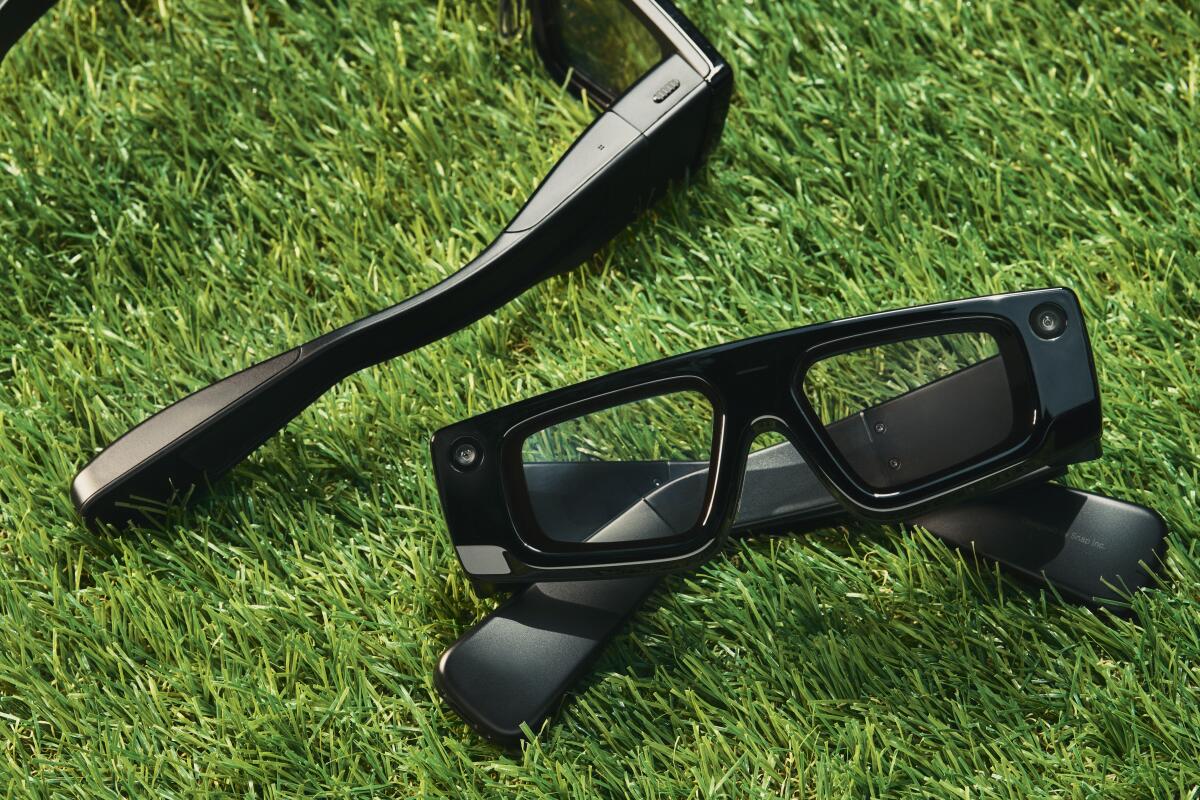A computer on your face? Snap and others still trying to make augmented reality glasses a reality

- Share via
In its relentless search for ways to weave digital products into people’s lives, Big Tech has achieved some big wins. Smart phones are ubiquitous. Apple Watch users talk to their wrists. Artificial intelligence-powered assistants are everywhere.
But convincing people to wear computers on their faces has been a dud. So far, at least.
Augmented reality glasses overlay digital images onto a person’s view of the physical world. They’re different from virtual reality headsets that fully immerse people into a computer-generated environment.
Tech giants have been focused in the last decade on developing glasses that project digital screens in front of a user’s eyes. The fact that they have so far failed to convince people to wear smart glasses daily hasn’t deterred Google and other companies from pouring money into the effort as they pursue a belief that the hardware could one day reshape how people socialize, work and learn.
Although dwarfed by the Silicon Valley behemoths to the north, Snap, the Los Angeles-based company behind the disappearing messaging app Snapchat, is competing in this smart glasses arms race. The company, which unveiled its fifth version of AR glasses at its annual conference Tuesday, hopes improving the device will drive mass consumer adoption.
“Making augmented reality glasses is really hard. And we know that the industry is littered with companies that have tried, and we’ve been working for a really long time on these,” Snap Chief Executive Evan Spiegel said Tuesday from the stage at the conference as he unveiled the glasses.
Other industry giants including Google and Samsung are also working on smart glasses, and Apple is exploring the idea. The competition raises the stakes for the publicly traded Snap as it looks to new products to help reassert itself in the tech world as rivals such as Instagram and TikTok have surged past it to capture eyeballs and market dominance.
Investment in tech startups in the Los Angeles region were down sharply last year from 2021, as the city has struggled to promote itself as an alternative to Silicon Valley and New York.
But a future in which augmented reality glasses are a part of our daily lives hasn’t arrived yet and a long road still remains ahead, experts say. The future of smart glasses is still murky.
“This is a marathon. It’s not a sprint,” said Tuong Huy Nguyen, an analyst at Gartner who is part of a team that researches immersive technologies including AR. “We need an ecosystem of not just hardware and software but content to work together to create seamless experiences.”
Snap first released smart glasses that could record video in 2016, selling them in vending machines in Los Angeles before making them available online. The company reported selling 150,000 pairs, but most people stopped using them after a month and underwhelming demand for the gadget resulted in hundreds of thousands of unsold pairs.
Named Spectacles, Snap’s latest eyewear overlays computer-generated images onto a person’s view of the physical world. The new device builds on the first AR glasses Snap released to software developers in 2021. Snap isn’t selling them to the public but is making them available to software developers in hopes they’ll design experiences for the platform.

What people can do with AR glasses remains limited. Snap’s glasses can track a person’s hands, allowing users to pick up and assemble virtual Legos, swing a phantom golf club, draw with friends and punch numbers in a digital calculator. The device also incorporates some artificial intelligence features that allow users to get answers to questions and conjure an image with a voice command.
In an attempt to drum up interest, Snap has been leaning into whimsical applications and gaming experiences that it knows users are used to, said Ben Bajarin, chief executive and principal analyst at Creative Strategies, a consulting firm that works with tech companies.
When a tech company moved into a house next to her Venice Beach boardwalk sunglasses stand three years ago, Maria Shim had no idea that it would eventually become her competition.
But Snap is still treading cautiously as it releases new AR glasses.
“What we can’t predict is consumer adoption and so that’s why we’re taking this more thoughtful approach to how we’re releasing this version,” said Sophia Dominguez, Snap’s director of AR Platform. “It could change at any time, and if it does change … we’re ready to go.”
Dominguez said the company envisions AR glasses one day becoming the primary way people access the digital world. Instead of computer or phone screens, AR glasses, she said, will allow people to keep one foot in each world simultaneously, making it “easy for you to interact with technology in the same way that you interact with the real world.”
Skepticism whether AR glasses will make this possible runs high.
Donning AR glasses could interfere with how people socialize in the physical world, making them feel less present, said Jeremy Bailenson, a Stanford University professor who founded the college’s virtual human interaction lab.
“Wearing glasses that connect you to digital content, whether it’s AR or VR, should be done sparingly for special experiences,” he said. “I am not an advocate of blocking your perceptual system, sight and sound, for constant surveillance.”
Bailenson and other Stanford researchers tested out the Meta Quest 3, a “mixed reality” headset that lets people blend physical and virtual worlds. While the headset is different from AR glasses, the gadget can display real-time video of a user’s surroundings in the physical world.
Researchers, who were accompanied by a chaperone for safety reasons, wore Meta’s headsets while chatting with people, walking around campus and cooking food. They reported that people in the physical world felt less real, as if they were watching television rather than interacting with someone face to face.
People wearing AR glasses will also see a different view of the world than people not wearing the devices, and losing that “common ground” will probably affect the way people socialize, Bailenson said.
Previous attempts at integrating smart glasses into people’s lives have not gone well. When Google released smart glasses in 2013 that could shoot photos and videos, they sparked privacy and safety concerns from consumers, lawmakers and business owners. People started calling Google Glass owners who used the smart glasses in ways that were socially unacceptable “glassholes.” Among the social no-nos: surreptitiously recording others and reading on the device while seeming to ignore others.
And while AR glasses have the potential to be helpful in several arenas, including training, education, shopping and gaming, industry analysts said it will be difficult convincing consumers to embrace the devices.
“Our eyes are very precious real estate,” said Bajarin, who tried out Snap’s AR glasses ahead of the conference. “Consumers are going to guard that very, very heavily.”
Keeping the price low enough to entice people to buy also will be a challenge. Meta, which partnered with Ray-Ban on a pair of smart glasses that enable people to capture photos, listen to music and take video calls with the help of an AI assistant, sells its device for about $300. Snap has not said what it will charge for its latest glasses should they become available to the public.
Snap Chief Executive Evan Spiegel has managed to keep the social media company alive and relevant — no small feat in the constantly evolving tech world.
Snap’s glasses remain a work in progress. They’re heavier than regular glasses, heat up to an uncomfortable degree after extended use and have a battery that lasts less than an hour. They require foreign hand movements, such as reaching out to pinch digital objects in the air and tapping the front and back of one’s hand to adjust the volume or launch a menu.
The device is powered by Snap’s own operating system, giving the company more control over the experience. During a recent preview of the AR glasses held in a San Francisco home, a Times reporter used voice commands to create images that appeared almost instantly — a robot dog, Elsa from Frozen and the San Francisco skyline.
In another activity, a wide-eyed, yellow creature appeared before making its way outside to a real San Francisco patio with a stunning view of the city. Niantic, the maker of AR game Pokemon Go, created the experience Peridot Beyond for Snap’s AR glasses.
Asim Ahmed, who leads global marketing at Niantic, said AR glasses give the company the opportunity to experiment and design a “new kind of paradigm of gameplay.” What works in a game played on a mobile phone might not work on AR glasses, which offer a wider field of view and don’t rely so heavily on hands to play. Niantic also had to think about safety issues, including making sure the virtual pet doesn’t get too close to the owner and block their view.
With an array of challenges, including figuring out how to jam processing power and other computing hardware into a device that is smaller than a smartphone, analysts predict it will take several years at least before smart glasses gain mainstream adoption, if they ever do.
In the first quarter of 2024, shipments of VR and AR headsets dropped 67.4% year over year, but they are expected to improve as consumers transition to new types of devices, according to market intelligence firm IDC. Meta led the market, followed by ByteDance, Xreal and HTC.
With companies still testing out AR glasses or developing them, a clear front-runner hasn’t emerged yet, analysts said.
Jacob Bourne, an analyst at Emarketer, said Snap’s rivals, including Meta and Google, have more money to invest in research and development of AR glasses. Meta, which owns Facebook, Instagram and WhatsApp, has 3.27 billion people using one of its apps every day. Snapchat has 432 million daily active users.
“I would probably put my money more on Meta as having the key to the [research and development] capabilities to really get that to market,” Bourne said. “But I wouldn’t rule Snap out at all.”
More to Read
Inside the business of entertainment
The Wide Shot brings you news, analysis and insights on everything from streaming wars to production — and what it all means for the future.
You may occasionally receive promotional content from the Los Angeles Times.














